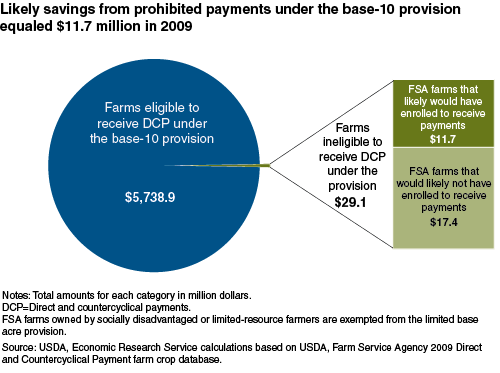Limited Base Acre Provision in the 2008 Farm Act Yields Small Budgetary Savings
- by Christine Arriola and Barry Krissoff
- 3/1/2012
Increasing Government budget deficits have put Federal farm program payment limitations at the forefront of discussions concerning future farm legislation. Farm payment limitations and eligibility provisions have been included in farm acts for at least 40 years. Recent limitations reduce or eliminate payments to individuals or farms earning income over a certain threshold. For example, the Food, Conservation, and Energy Act of 2008 (the 2008 Farm Act) stipulated that a person or legal entity with adjusted annual gross farm income of over $750,000 (averaged over previous 3 years) was not eligible for direct payments.
The 2008 Farm Act also included elimination of small payment amounts as both an administrative cost savings to USDA's Farm Service Agency (FSA), which administers the payments, and a budgetary savings. The 'base-10' provision of the 2008 Farm Act prohibits farms with 10 or fewer base acres from receiving direct and countercyclical payments (DCP) or average crop revenue election (ACRE) program payments (see 'New Market Realities Affect Crop Program Choices' in the November 2008 issues of Amber Waves). Limited-resource and socially disadvantaged owners were exempt from this provision.
Savings achieved through the base-10 provision appear to be small relative to total DCP and ACRE payments. Nearly 371,000 farms (as defined by FSA) of the 2.2 million with base acres became ineligible for payments under the provision. Since the affected farms controlled only 1.6 million, or 0.6 percent, of total base acres in 2009, prohibited payments totaled $29.1 million, compared with over $5 billion total DCP and ACRE payments in 2009.
The actual savings were probably even smaller, since not all operators of FSA farms enroll in commodity programs in a given year. For farmers choosing not to participate, the payment may not be sufficient to entice the farmer to process the paperwork. Operators affected by the base-10 provision would have forgone an average of $79 per farm in 2009. In 2008, prior to implementation of the base-10 provision, 40 percent of FSA farms with 10 or fewer base acres enrolled in the DCP program. If a 40-percent enrollment rate is applied to 2009 data, 148,400 farms would no longer receive payments, resulting in a savings of $11.7 million. The administrative cost savings would bring another $1.5 million, for a total savings of $13.2 million in 2009.
This article is drawn from:
- Arriola, C., Krissoff, B., Young, E., Harwood, J. & You, C. (2011). An Analysis of the Limited Base Acre Provision of the 2008 Farm Act. U.S. Department of Agriculture, Economic Research Service. EIB-84.
We’d welcome your feedback!
Would you be willing to answer a few quick questions about your experience?


